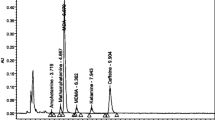Abstract
Ecstasy is an amphetamine-type substance that belongs to a popular group of illicit drugs known as “club drugs” whose consumption is rising in Brazil. The effects caused by this substance in the human organism are mainly psychological, including hallucinations, euphoria and other stimulant effects. The distribution of this drug is illegal, and effective strategies are required in order to detain its growth. One possible way to obtain useful information on ecstasy trafficking routes, sources of supply, clandestine laboratories and synthetic protocols is by its chemical components. In this paper, we present a data mining and predictive analysis for ecstasy tablets seized in two cities of São Paulo state (Brazil), Campinas and Ribeirão Preto, based on their chemical profile. We use the concentrations of 25 elements determined in the ecstasy samples by ICP-MS as our descriptive variables. We develop classification models based on support vector machines capable of predicting in which of the two cities an arbitrary ecstasy sample was most likely to have been seized. Our best model achieved a 81.59% prediction accuracy. The F-score measure shows that Se, Mo and Mg are the most significant elements that differentiate the samples from the two cities, and they alone are capable of yielding an SVM model which achieved the highest prediction accuracy.


Similar content being viewed by others
References
Almeida SP, Silva MTA (2013) Ecstasy (MDMA): effects and patterns of use reported by users in São Paulo. Rev Bras Psiquiatr 25:11–17
Barbosa R, Nelson D (2016) The use of support vector machine to analyze food security in a region of brazil. Appl Artif Intell 30(4):318–330
Batista BL, Rodrigues JL, Souza VCO, Barbosa F Jr (2009) A fast ultrasound-assisted extraction procedure for trace elements determination in hair samples by ICP-MS for forensic analysis. Forensic Sci Int 192:88–93
Brown SD, Melton TC (2011) Trends in biological methods for the determination and quantification of club drugs: 2000–2010. Biomed Chromatogr 25:300–321
Burges CJC (1998) A tutorial on support vector machines for pattern recognition. Data Min Knowl Discov 2:121–167
Chandrashekar G, Sahin F (2014) A survey on feature selection methods. Comput Electr Eng 40:16–28
Chen Y, Lin C (2006) Combining SVMs with various feature selection strategies. In: Guyon I, Nikravesh N, Gunn S, Zadeh LA (eds) Feature extraction, studies in fuzziness and soft computing, vol 207. Springer, Berlin Heidelberg, pp 315–324
Comment S, Lock E, Zingg C, Jakob A (2001) The analysis of ecstasy tablets by ICP-MS and ICP/AES. Probl Forensic Sci 46:131–146
Cortes C, Vapnik V (1995) Support-vector networks. Mach Learn 20:273–297
Dash M, Liu H (1997) Feature selection for classification. Intell Data Anal 1:131–156
Delen D, Cogdell D, Kasap N (2012) A comparative analysis of data mining methods in predicting NCAA bowl outcomes. Int J Forecast 28:543–552
Delen D, Walker G, Kadam A (2005) Predicting breast cancer survivability: a comparison of three data mining methods. Artif Intell Med 34:113–127
Duda RO, Hart PE, Stork DG (2000) Pattern classification, 2nd edn. Wiley-Interscience, New York
Fawcett T (2006) An introduction to ROC analysis. Pattern Recogn Lett 27:861–874
Fierro I, Deban L, Pardo R, Tascón M, Vázquez D (2007) Analysis of heavy metals in ecstasy tablets by electrochemical methods. Toxicol Environ Chem 89:411–419
French HE, Went MJ, Gibson SJ (2013) Graphite furnace atomic absorption elemental analysis of ecstasy tablets. Forensic Sci Int 231:88–91
Guyon I, Elisseeff A (2003) An introduction to variable and feature selection. J Mach Learn Res 3:1157–1182
Hamel LH (2009) Knowledge discovery with support vector machines. Wiley-Interscience, New York
Koper C, van den Boom C, Wiarda W, Schrader M, de Joode P, van der Peijl G, Bolck A (2007) Elemental analysis of 3,4-methylenedioxymethamphetamine (MDMA): a tool to determine the synthesis method and trace links. Forensic Sci Int 171:171–179
Maione C, de Paula ES, Gallimberti M, Batista BL, Campiglia AD, Barbosa F Jr, Barbosa RM (2016) Comparative study of data mining techniques for the authentication of organic grape juice based on ICP-MS analysis. Expert Syst Appl 49:60–73
Maione C, Batista BL, Campiglia AD, Barbosa F Jr, Barbosa RM (2016) Classification of geographic origin of rice by data mining and inductively coupled plasma mass spectrometry. Comput Electron Agric 121:101–107
Nigam K, Mccallum AK, Thrun S, Mitchell T (2000) Text classification from labeled and unlabeled documents using EM. Mach Learn 39:103–134
Polat K, Güneş S (2007) Breast cancer diagnosis using least square support vector machine. Digit Signal Process 17:694–701
R Core Team (2014) R: a language and environment for statistical computing. R Foundation for Statistical Computing, Viena. http://www.R-project.org/
Schäffer M, Dieckmann S, Pütz M, Kohles T, Pyell U, Zimmermann R (2013) Impact of reaction parameters on the chemical profile of 3,4-methylenedioxymethamphetamine synthesized via reductive amination: target analysis based on GC-qMS compared to non-targeted analysis based on GCxGC-TOF-MS. Forensic Sci Int 233:201–211
Schneider K (2003) A comparison of event models for Naive Bayes anti-spam e-mail filtering. In: Proceedings of the tenth conference on european chapter of the association for computational linguistics—volume 1, EACL ‘03, Budapest, Hungary. Association for Computational Linguistics, Stroudsburg, pp 307–314
Tan P, Steinbach M, Kumar V (2005) Introduction to data mining, 1st edn. Addison-Wesley Longman Publishing Co., Inc., Boston
Tong S, Koller D (2002) Support vector machine active learning with applications to text classification. J Mach Learn Res 2:45–66
Waddell RJ, NicDaéid N, Littlejohn D (2004) Classification of ecstasy tablets using trace metal analysis with the applications of chemometric procedures and artificial neural network algorithms. Analyst 129:235–240
Zain SM, Behkami S, Bakirdere S, Koki IB (2016) Milk authentication and discrimination via metal content clustering—a case of comparing milk from Malaysia and selected countries of the world. Food Control 66:306–314
Acknowledgements
The authors are grateful to Fundação de Amparo à Pesquisa do Estado de São Paulo (FAPESP) and Conselho Nacional de Desenvolvimento Científico e Tecnológico (CNPq) for financial support.
Funding
This study was funded by São Paulo Research Foundation (FAPESP) and the National Council for Technological and Scientific Development (CNPq).
Author information
Authors and Affiliations
Corresponding author
Ethics declarations
Conflict of interest
All authors declare that they have no conflict of interest.
Ethical approval
This article does not contain any studies with human participants or animals performed by any of the authors.
Rights and permissions
About this article
Cite this article
Maione, C., Souza, V.C.O., Togni, L.R. et al. Establishing chemical profiling for ecstasy tablets based on trace element levels and support vector machine. Neural Comput & Applic 30, 947–955 (2018). https://doi.org/10.1007/s00521-016-2736-3
Received:
Accepted:
Published:
Issue Date:
DOI: https://doi.org/10.1007/s00521-016-2736-3




